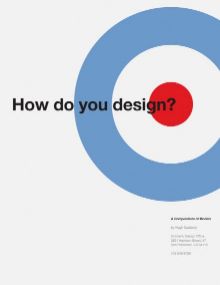How do you design? |

|
 Diese Seite wurde seit 1 Jahr inhaltlich nicht mehr aktualisiert.
Unter Umständen ist sie nicht mehr aktuell.
Diese Seite wurde seit 1 Jahr inhaltlich nicht mehr aktualisiert.
Unter Umständen ist sie nicht mehr aktuell.
 Zusammenfassungen
Zusammenfassungen
 Everyone designs. The teacher arranging desks for a discussion. The entrepreneur planning a business. The team building a rocket.
Everyone designs. The teacher arranging desks for a discussion. The entrepreneur planning a business. The team building a rocket.Their results differ. So do their goals. So do the scales of their projects and the media they use. Even their actions appear quite different. What’s similar is that they are designing. What’s similar are the processes they follow.
Our processes determine the quality of our products. If we wish to improve our products, we must improve our processes; we must continually redesign not just our products but also the way we design. That’s why we study the design process. To know what we do and how we do it. To understand it and improve it. To become better designers.
In this book, I have collected over one-hundred descriptions of design and development processes, from architecture, industrial design, mechanical engineering, quality management, and software development. They range from short mnemonic devices, such as the 4Ds (define, design, develop, deploy), to elaborate schemes, such as Archer’s 9-phase, 229-step "systematic method for designers." Some are synonyms for the same process; others represent differing approaches to design.
 Dieses Buch erwähnt ...
Dieses Buch erwähnt ...
 Personen KB IB clear | Frederick P. Brooks | ||||||||||||||||||
 Begriffe KB IB clear |  Design Design design
, design
,  design thinking design thinking
| ||||||||||||||||||
 Bücher |
|
 Zitationsgraph (Beta-Test mit vis.js)
Zitationsgraph (Beta-Test mit vis.js)
 Volltext dieses Dokuments
Volltext dieses Dokuments
 |  How do you design?: Gesamtes Buch als Volltext ( How do you design?: Gesamtes Buch als Volltext ( : :  , 399 kByte; , 399 kByte;  : :  2021-03-21) 2021-03-21) |
 Anderswo suchen
Anderswo suchen 
 Beat und dieses Buch
Beat und dieses Buch
Beat hat dieses Buch während seiner Zeit am Institut für Medien und Schule (IMS) ins Biblionetz aufgenommen. Beat besitzt kein physisches, aber ein digitales Exemplar. Eine digitale Version ist auf dem Internet verfügbar (s.o.). Aufgrund der wenigen Einträge im Biblionetz scheint er es nicht wirklich gelesen zu haben. Es gibt bisher auch nur wenige Objekte im Biblionetz, die dieses Werk zitieren.









 Biblionetz-History
Biblionetz-History